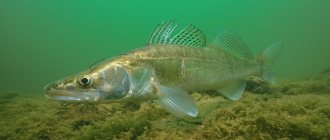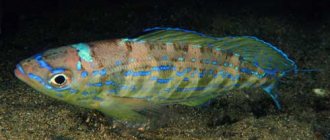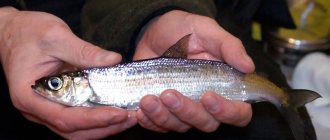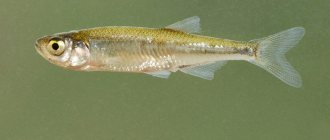a brief description of
Roach is a typical representative of the carp family. Its value lies in both its excellent taste and the benefits that the beneficial components of the fish bring to the human body.
What does it look like?
The appearance of the roach is memorable: the fish has an oval oblong body, which increases with age, becoming wider and thicker. The entire surface of the body is covered with scales. On the dorsal side they are black, with a bluish and greenish tint. The scales on the sides and abdomen have a silvery-white tint.
In total, roach has 5 types of fins:
- dorsal;
- tail;
- abdominal;
- anal;
- chest
The color of scales and fins can vary depending on the species, age of the fish, as well as living conditions and even the composition of the water.
Dimensions and weight
Roach is a medium-sized fish. Usually its length does not exceed 30 cm, and its weight ranges up to 500-600 g. However, some types of roach, for example inhabitants of the Caspian and Azov seas, can reach large sizes - up to 2 kg.
Is this a river or sea fish?
Unambiguously answer the question: “Is roach a river or sea fish?” - it is forbidden. This is because it lives in rivers, lakes, ponds, and some seas. For the latter, there is an important rule: it can only be found in low-salt waters, for example, in the Azov, Caspian or Black Sea.
Where does it live and how long does it live?
Roach habitats are quite extensive, but usually these are water bodies densely overgrown with algae. © https://ydoo.info/product/plotva.htmlThe main habitats for fish are considered to be the basins of the Azov and Black Seas, Lake Baikal, the Seyakha River, as well as other rivers and lakes of Europe.
The roach can be called the longest-lived among fish. Its average lifespan is 8-15 years.
Is this a bony fish?
The roach is quite bony, especially the small ones. Some consider this a disadvantage, but if you know the secrets of cooking fish, which will be described below, this problem can be easily solved.
Taste
The taste of roach is very delicate, with a characteristic pronounced fishy taste. Some claim that roach tastes like canned fish.
Smell
When fresh, roach has virtually no odor. But in the finished dish it reveals its properties, emitting an appetizing aroma of fried, boiled, dried or smoked fish.
Nutrition and reproduction
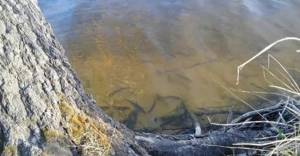
Roach fish are numerous and quite voracious. Due to its abundance in a particular body of water, it can influence the population of other fish species. By eating food, it simply limits the nutrition of other, more valuable species. This is probably why it is considered a trash fish.
In artificial reservoirs, the bridge is often calibrated in size. As a rule, these are small roaches, weighing 50 - 100 grams, although they can reach much larger sizes.
Puberty occurs already at the age of two to three years. It begins to spawn as soon as the water warms up sufficiently off the coast in shallow water. This time approximately coincides with the spawning of young bream (large bream spawns much later).
During the spawning period, the roach changes its appearance and becomes rough. In males, the fins become bright red. The process itself is not noisy, but it is not difficult to notice. Fish rub in shallow water against all sorts of obstacles: stones, snags, underwater vegetation. The stems of underwater grass constantly move from the touch of fish. From time to time the roach manifests itself in bursts.
From the moment the eggs are laid and fertilized until the fry hatches, it takes about two weeks. Subsequently, the growth of the fish greatly depends on the food supply of the reservoir; in the first days of life they feed on plankton. Later they move on to small larvae and insects. Roach grows fastest in bodies of water where there is a lot of greenery and the water warms up quickly. You can see a small rut in coastal vegetation or near the surface throughout the warm water season. Only when it gets colder does the small stuff move away from the shore.
Varieties of roach
Although the debate about whether it is worth dividing roach into subspecies has not subsided to this day, today there are 4 main types of this fish known:
- Common roach. Found in all of the above habitats with equal frequency.
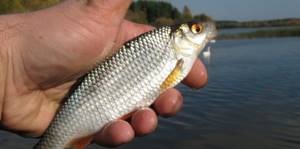
- Siberian roach, or chebak. This species is widespread in the Arctic Ocean basin, in the waters of the Urals and Western Siberia.
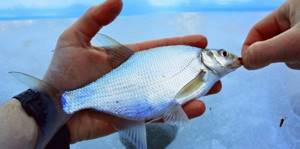
- Ram. They are caught in the rivers of the Azov and Black Sea basins.
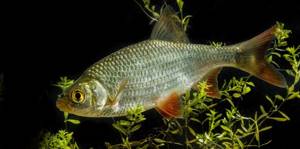
- The Aral roach, or roach, is common in the Aral Sea and the rivers flowing into it.
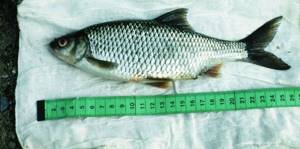
Habitats
The roach is found in Europe, in the basins of the Caspian and Aral seas. In Russia, it is found in reservoirs of the Urals, Siberia and the Far East. In the rivers of Siberia the name Siberian roach is used.
The fish is unpretentious and therefore easily takes root in many reservoirs.
Roaches are found in reservoirs, lakes, large and small rivers. This fish is schooling and the smaller the roach, the larger the schools. It lives in a depth range from one to five meters, sometimes deeper. Favorite places in large bodies of water are flat areas of the bottom, where the depth is on average 3 - 5 meters. Usually the roach swims a little above the bottom, but there are days when it stands at half-water or near the surface. This is primarily due to weather conditions.
We recommend reading: Black Sea scorpionfish ruffe
In large rivers, the chebak fish chooses similar places as in standing reservoirs, constantly moving in schools. In small rivers, it looks for return paths, areas with slow flows and all kinds of backwaters. It often stands below the riffles, waiting for food brought by the current. Usually these are sandy spits or rocky areas. But the chebak does not like to stand in a strong current, just as it does not like too cold water.
Roaches live in large numbers in lowland rivers with weak or medium currents. The fact is that such rivers usually do not have areas with fast currents and are full of aquatic vegetation. In the aquatic grass, the roach finds a lot of food and shelter.
How is it different from other fish?
The difference between roach and other fish lies not only in appearance, but also in taste characteristics.
From roach
In fact, roach is a type of roach. This species is distinguished by its large body size, but in other characteristics the roach and roach are similar.
As for taste, the fish have a similar taste, which is why they are prepared according to the same recipes.
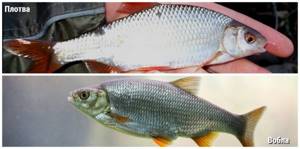
From chub
It is impossible to confuse chub and roach by appearance. Unlike the elongated and rounded body of the roach, the chub has a cylindrical body shape. He has a wider mouth and a blunt nose.
Although the color of the scales of these fish is similar (the back has a dark green tint and the belly is light), the lateral parts are somewhat different. The roach in this place has silvery-white scales, while the chub has silvery-yellow scales.
Representatives of both species taste juicy and soft. Which fish to choose depends only on the personal preferences of the cook.
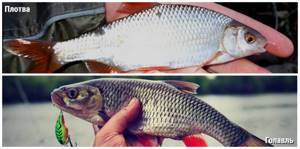
From rudd
The appearance of roach and rudd, namely the body structure, is almost the same, so these fish are often confused even by experienced fishermen. Nevertheless, they can be distinguished by the color of their scales: in the roach they are silvery-white, and in the rudd they are golden.
The rudd has more pronounced yellow lips and a rounded nose. But in terms of taste characteristics, roach is clearly the leader.
Many lovers of fish dishes note that roach has more juicy and tasty meat.
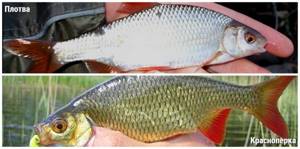
From the minnow
It is impossible to confuse a gudgeon and a roach. The gudgeon has a specific, easily recognizable appearance:
- oblong, fusiform body;
- green color of scales on the upper part of the body;
- a mustache located near the protruding lip;
- large eyes located in the frontal part of the head;
- unusual dorsal fin, similar to a regular triangle.
It is not easy to compare fish in terms of taste characteristics. Gudgeon has a sweeter taste of meat, and roach has a more neutral taste, so there is a fan for each type.
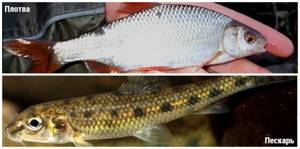
From dace fish
As for the dace, it, unlike the roach, has a body that is more elongated and flattened on the sides. Dace is also smaller in size: it usually grows up to 15 cm.
These fish can also be compared by the color of their scales: in roach, their shades change depending on the part of the body, but dace has a lighter shade. Its sides are light blue, its back is dark gray, but equally shiny, and its belly is silvery-white.
The taste qualities of dace and roach are equally high. Both fish have tender, pleasant-tasting meat.

From soroga (sorozhka)
Soroga is another name for the common roach. This is just one of many synonyms for the scientific name of the fish.
From ramming
Taran is a subspecies of roach common in the Black Sea region. It is often caught in the basins of the Azov and Black Seas.
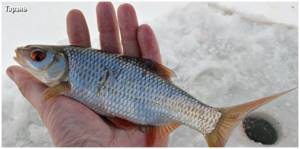
From bleak
Bleak and roach are completely different types of fish. Despite the fact that they have a similar color of scales, their appearance has significant differences. Bleak is a small (up to 20 cm) fish with an oblong body. Its weight, unlike roach, does not exceed 60-80 g.
In cooking, bleak is used in dishes where the small size of the fish is important. For example, it makes excellent sprats. And roach is suitable for more serious dishes.
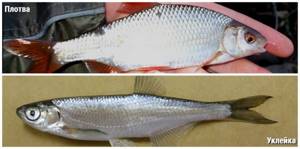
From chebak
Chebak is a famous species of roach. Being a representative of the Siberian subspecies, chebak is widely used in the industrial production of canned fish and other preparations.
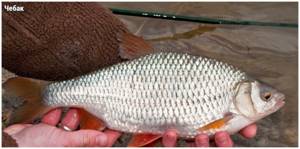
From ide
The body shapes of ide and roach are similar: the same elongated, rounded body, equal number of fins and their arrangement. The main difference between fish is the color of their scales:
- ide has a rich yellow tint of scales;
- roach – silvery-white.
The taste of both ide and roach is unusually soft and juicy, with a pleasant aroma of the finished dish.
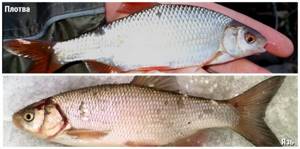
Catching
Medium and small specimens of the chebak are not shy, so even people who have picked up a fishing rod for the first time will be able to catch several kilograms in a short period of time. The end of spring and the month of June, when the fish gather in small schools and come out to feed in shallow water, is the best time for fishing.
Amateur fishermen catch chebak on a float rod, having previously fed it with porridge, corn, steamed peas, pearl barley with a small amount of aromatic additives (spicy, meat, fish). For fishing, it is better to choose a place without a current, shallow water overgrown with algae, reaches. They go out for large fish either in the early morning or closer to night, small and medium-sized fish are caught throughout the day.
The following are used as bait: maggots, worms, bread products, semolina or flour dough, caddis flies, algae, rolled oatmeal flakes. Fishing for a subspecies of roach is easy, it is light (in most cases up to 500 grams) and gets tired quickly, the main thing is not to pull the line under a snag; for this you need to constantly keep it taut. Choose a line of the smallest diameter, working - 0.14 mm, for leashes 0.10-0.12 mm.
Three types of fishing rods are used for bottom fishing:
- Donka with a reel.
- Rubber.
- Feeder.
The reel is taken for 70-100 meters of fishing line - this is convenient for fishing or in case of accidental breakage of gear.
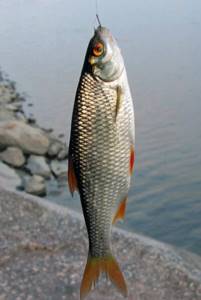
How to choose?
Fresh roach has to be selected “by eye”. To avoid making a mistake with your choice, you should pay attention to:
- Eye condition. In fresh fish they are clear, without spots, bruises or cloudiness.
- Gill color. Their bright red hue will indicate a fresh product, but dark or gray gills will indicate that the fish is stale.
- Smell. A good product either has a subtle fishy smell or no smell at all. Extraneous unpleasant aromas will help identify unedible fish.
- The elasticity of the fish carcass: if, when pressing on the fish, the stain that appears does not disappear, the fish is definitely stale.
How to store?
The optimal place to store roach is the refrigerator. There, at a temperature of 0...+5 °C, the fish remains fresh for 24 hours.
Taking into account the commercial proximity, a place for roach in the refrigerator is chosen away from dairy products, vegetables and fruits. For roach frozen in the freezer, the shelf life is extended to 6 months.
It is better to defrost the roach gradually: put it on a plate and put it in the refrigerator.

Behavior
It is useful for fishing enthusiasts to know where to look for Siberian roach, at what time and how it behaves. Tree snags sticking out of the water, drifting drifts of driftwood and grassy debris - this is where schools of unpretentious fish hide.
Twice a year, in the second half of summer and closer to autumn, chebak fish gather in small schools and go out to feed closer to the shores; for 10 days they greedily consume algae and small insects. At this time, they are commercially fished. They spend the winter at the bottom, but do not fall asleep, but continue to feed (backwater fish), which pleases winter fishing enthusiasts.
How to prepare?
Like other types of fish, roach needs to be prepared before cooking. Although small fish are sometimes cooked with scales, both them and large fish must be gutted and cut up.
How to quickly remove scales?
Cleaning a roach is easy. In young fish, the scales can be easily removed even with your hands, and to clean adult fish you can use a knife or a special brush for cleaning fish.
To prevent the scales from scattering in different directions, the roach must be kept under water while cleaning. To do this, pour liquid into a small saucepan or basin and, having immersed the fish inside, run a knife along the entire body, removing the scales. In the same way, you can clean the scales using:
- kitchen grater with large holes;
- special device for cleaning fish;
- a device made with your own hands (3-4 iron lids are nailed onto an oblong piece of wood, the ribbed side of which perfectly cleans the scales).
Using any method, it is worth remembering that the fish is always cleaned in the direction from the tail to the head. You should also trim the fins first to avoid injury while removing the scales.
How to cut and gut?
Before you start preparing the dish, the roach must be gutted and cut up.
To remove the entrails, use a sharp knife to make a cut along the entire length of the belly, widen the hole with your fingers and remove all the entrails. This method of preparing fish is suitable for recipes in which the roach is cooked whole.
You can start cutting roach into fillets without preliminary gutting. First, a cut is made with a knife along the length of the belly, after which, laying the fish on one side, the meat is pryed off at the head fin and cut off all the way to the tail. Having separated one part, the fish is turned over on the other side and the described steps are repeated.
Then they begin to separate the scales: place a piece of fillet on a kitchen board with the meat facing up and, holding the tail end, make an incision as close as possible to the scales and gradually separate it. The cleaned fillet is ready for cooking.
How to make minced roach?
Minced roach is perfect for making fish cutlets. The sequence of preparing minced meat is as follows:
- The fish are washed, cleaned, gutted and heads cut off.
- All fish are passed through a meat grinder or food processor.
- For 1 kg of fish, take 5 medium potatoes and a head of garlic, which are also peeled and ground.
- All ingredients are ground and salt and pepper are added to the minced meat.
Habits and taste preferences
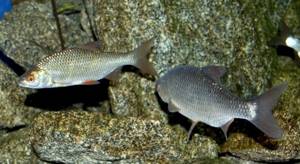
Small and medium-sized roaches are not shy and are quite curious. If you throw a piece of bread into the water next to a swimming flock, they swim up quite quickly, allowing you to get a good look at them. This trick will not work with a large individual. Finding a large herring is generally problematic. She often keeps to herself, although at times she is found among a large flock.
The roach moves slowly, one might say impressively. Even in winter, when fishing with a jig, she prefers a slow and smooth game. Although, of course, there are exceptions.
Roach feeds on worms, larvae of various insects, bottom organisms, molluscs and even greens. Eats plant foods well in summer: bread, semolina, pearl barley and other cereals, peas, corn, etc. This fish is an omnivore, eats a lot and grows relatively quickly.
During the period of mass flight of insects, the track often walks in the upper layers of water, picking up midges, small grasshoppers, mosquitoes, flies and beetles that have fallen into the water. At this time, she gives herself away with frequent bursts. This is most often observed in the morning and evening; in calm weather, the meal can last all day.
We recommend reading: Amur black bream
Cooking methods
Deliciously cooked roach is considered the most popular fish dish. Roach is baked in the oven, fried in a frying pan, boiled, pickled, salted...
How to bake in the oven?
Oven-baked roach can be served with any side dish. The best recipe is considered to be roach baked in foil. It is prepared like this:
- The fish, previously cleaned of scales and entrails, is laid out on a sheet of foil.
- The roach is salted, sprinkled with a little lemon juice, and topped with rosemary.
- The fish is wrapped tightly in foil and placed in the oven.
- At a temperature of 180 °C, the roach is baked for 15-20 minutes. To get a crispy crust, you need to unroll the foil and bake the fish for another 5-10 minutes.
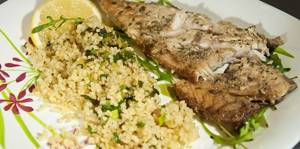
How to fry in a frying pan?
To fry roach in a frying pan, it is first cleared of scales, cut and washed under running water. If desired, the fish can be cut into pieces or fried whole. Each piece is salted and peppered.
Heat a frying pan over medium heat with a small amount of vegetable oil, into which the fish dredged in flour is placed. Fry the roach for 5-10 minutes on both sides (until a golden crust forms).
If you make large cuts along the surface of the fish with a knife, the bones will soften during cooking, and the roach itself will be juicier and softer.
How to cook?
Cooking roach is very simple:
- the prepared fish is placed in a pan, filled with water, salt and pepper;
- The dishes are placed on the stove;
- cook the roach for 10-15 minutes over medium heat.
Those who want to enjoy fish broth can cook roach with the addition of potatoes, carrots and herbs.
How to pickle?
To salt roach you will need a deep pan, basin or bucket. There is no need to clean the fish; the roach is salted along with the scales. The fish is laid out in layers in any of the indicated containers, alternating a layer of roach with a generous layer of salt. The last layer of fish is also carefully covered with salt so that it completely covers the roach.
After this simple procedure, the top layer of fish is covered with a lid and a press is installed, and then the structure is sent to the refrigerator. It is not advisable to leave fish in another cool place, such as a basement. This method is unreliable and the fish can spoil quickly.
After 2-4 days spent in the refrigerator, the roach is removed from the saucepan, washed under running water and threaded through the eye holes onto strong threads. After this, the roach is hung in a dry, well-ventilated room, covered with several layers of gauze to prevent damage to the fish by insects, and left until completely dry.
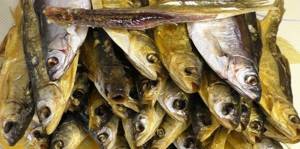
How to marinate?
It doesn’t take long to cook delicious pickled roach. Just 3 days after cooking, you can serve marinated fish to the table.
To prepare the dish you will need 2 kg of roach, cut into portions, 100 g of salt, several black peppercorns, bay leaf and onion. First of all, put the pieces of fish in a pan or jar, after which they are covered with salt, pepper and several bay leaves. Then add onion cut into half rings and pour in sunflower oil so that it covers the remaining ingredients.
Cover the container with fish with a lid and put it in the refrigerator for 2-3 days.
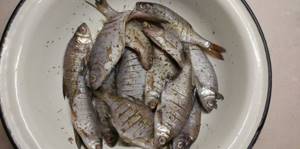
How to smoke?
There are 2 ways to smoke roach - cold and hot. The choice depends not only on personal preferences, but also on the time that the cook is willing to spend on creating the dish. The hot method takes 30-50 minutes to prepare the roach, but the cold method takes about 2 days.
Hot way
Before you start cooking, the roach needs to be prepared:
- clean off the entrails (do not get rid of the scales);
- rinse under running water;
- rub with salt on all sides;
- place in a deep saucepan, cover with salt in layers, and leave in the refrigerator for 2 hours;
- Wash off the salt and dry with a napkin.
The roach, prepared according to all the rules, is laid out on the smokehouse grates, covered with a lid and started smoking.
Before putting the smokehouse on the fire, place a tray on the wood chips to prevent fat from dripping off.
The smoking time begins to count from the appearance of thick smoke, which will break out from under the lid in a dense haze. From this point on, the fish is smoked for 30-50 minutes, after which it is put out in a well-ventilated place for an hour (this helps get rid of the strong smell of the fire) and served.
Cold way
The cold smoking method allows you to evaporate excess moisture from the roach, leaving all the beneficial substances in the fish. Such roach acquires a pleasant smoky taste of meat and a beautiful golden hue of scales.
For the cold cooking method, you need a special smokehouse - a device that must be purchased in advance. Before cooking, the fish is also prepared:
- cleaned of entrails;
- washed;
- salted in the above manner or pickled.
For those who want to marinate fish, the following recipe is suitable: pour a glass of water, soy sauce, lemon juice and dry white wine into a pan, into which 30 g of fish seasoning is added. All ingredients are mixed and brought to 70 °C on the stove, after which the marinade is cooled and poured over the roach. The fish will marinate in the refrigerator for about 12 hours. After the specified time, the roach is taken out, hung on threads and left until completely dry.
The prepared roach is placed in a smokehouse and cooked at a temperature of 24-28°C for 2 days, after which the fish is again hung in a well-ventilated area for 3 days.
How to wilt?
You can wither both gutted and whole roaches. Small fish do not require cleaning of the entrails, but large catches should be prepared in advance.
The recipe for making roach is as follows:
- the fish are washed, the gills are removed and the carcasses are rubbed with salt on all sides;
- A layer of salt is placed on the bottom of the pan, and roach is placed on top of it;
- pour another layer of salt onto the layer of fish and repeat these steps if necessary;
- The roach is covered with a lid on top and a load is installed;
- place in the refrigerator for 3-4 days;
- remove from the refrigerator, transfer the fish to a clean container and fill with cold water for 2 hours;
- The roach is hung in a well-ventilated place for a period of 1 to 4 weeks.
How to dry it?
Salt roach for drying as follows:
- pour a layer of salt into a deep container;
- lay a layer of roach on top;
- pour the roach on top so that the salt covers the entire fish.
Then the roach is covered with a lid, a weight is placed on top and the structure is sent to the refrigerator for a couple of days. After this, they begin drying: they string the fish on a thick thread or twine and hang it in a room with good ventilation. In order for the fish to dry well, but remain fleshy and juicy, it should be hung in a place inaccessible to direct sunlight.
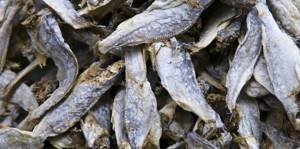
Peculiarities of roach behavior throughout the year
The behavior of roach, like other fish, depends on the time of year. After the ice melts, it stays near the shore, regardless of the size of the reservoir. Migrations up the river during the pre-spawning period are insignificant. After spawning, it is found in all areas of the reservoir, with the exception of places with fast currents.
We recommend reading: How to catch crucian carp in the spring on a feeder
During the summer heat, the fish rolls deeper or goes under steep banks, hiding in the roots of coastal vegetation. Grassy thickets are not the roach's favorite place to stay, although greenery is part of its diet. The roach stays close to the thickets, but rarely goes into the very thick of the grass. As for the places where fish stay during this period, they are different. Roach moves throughout the entire water column, but is most often found at a level of 10–20 cm from the bottom of the reservoir.
In late autumn, roaches concentrate in deeper places than in summer, finding a comfortable temperature and a suitable oxygen regime. There she spends most of the winter and early spring. In winter, it becomes inactive, although it does not completely stop moving around the reservoir. During the season of closed water, it gives greater preference to animal food. The main bait when catching it is bloodworms, less often bloodworms or maggots.
When feeding sorog, smell is important. The track is partial to sweet aromas, as well as the smell of anise, hemp, seeds, vanilla, etc. If you choose the right bait, you can reliably hold the fish for a long time.
The deterioration of the bite in winter becomes more severe, and the bite itself does not last as long as in the summer. Changes in atmospheric pressure, wind strength and direction, and precipitation in winter have a stronger effect on roach nutrition than in summer.
Benefits and harms
The main benefit of roach is associated with the high content of omega-3 polyunsaturated fatty acids in this fish. By making roach a regular food item, you can:
- strengthen blood vessels and heart muscle;
- establish metabolic processes in the body;
- prevent negative changes in the functioning of the nervous system;
- reduce the risk of memory impairment;
- improve vision;
- strengthen the structure of nails and hair;
- give skin elasticity and healthy color;
- increase the effectiveness of the diet.
Eating roach is considered dangerous only in a few cases. One of them is individual intolerance to fish, which can lead to an allergic reaction with all its manifestations. The second important reason why roaches can be harmful to health is the possibility of infecting the fish with helminths. To avoid infection with these parasites, all fish must be thoroughly cooked.
Roach may well become a regular food item for connoisseurs of fish and fish dishes. This easy-to-prepare, but incredibly tasty fish, prepared with care and love, will delight every family member.



